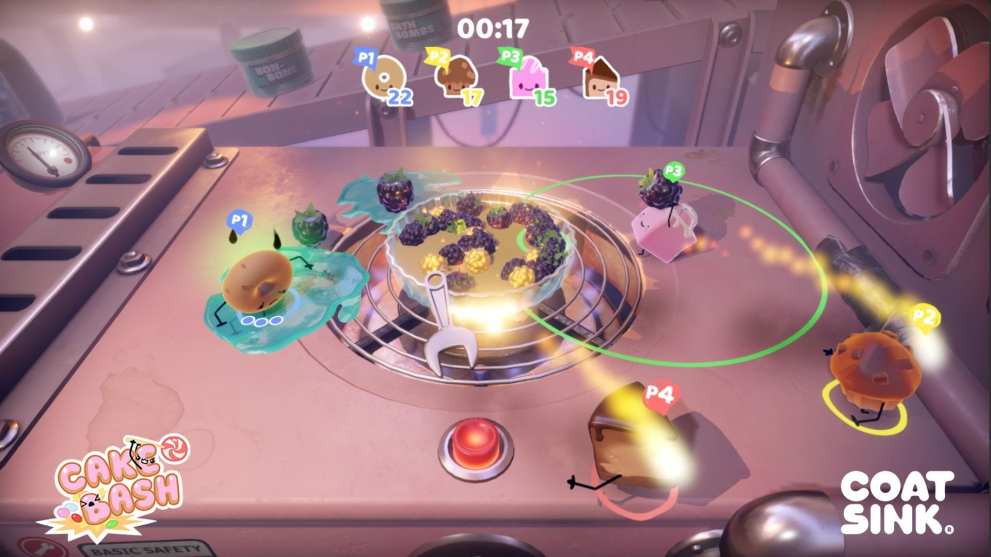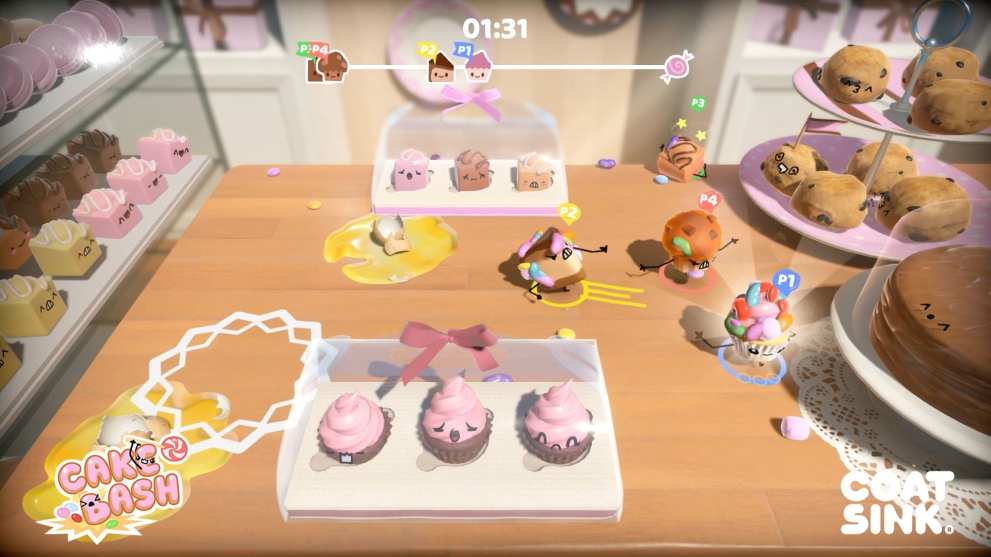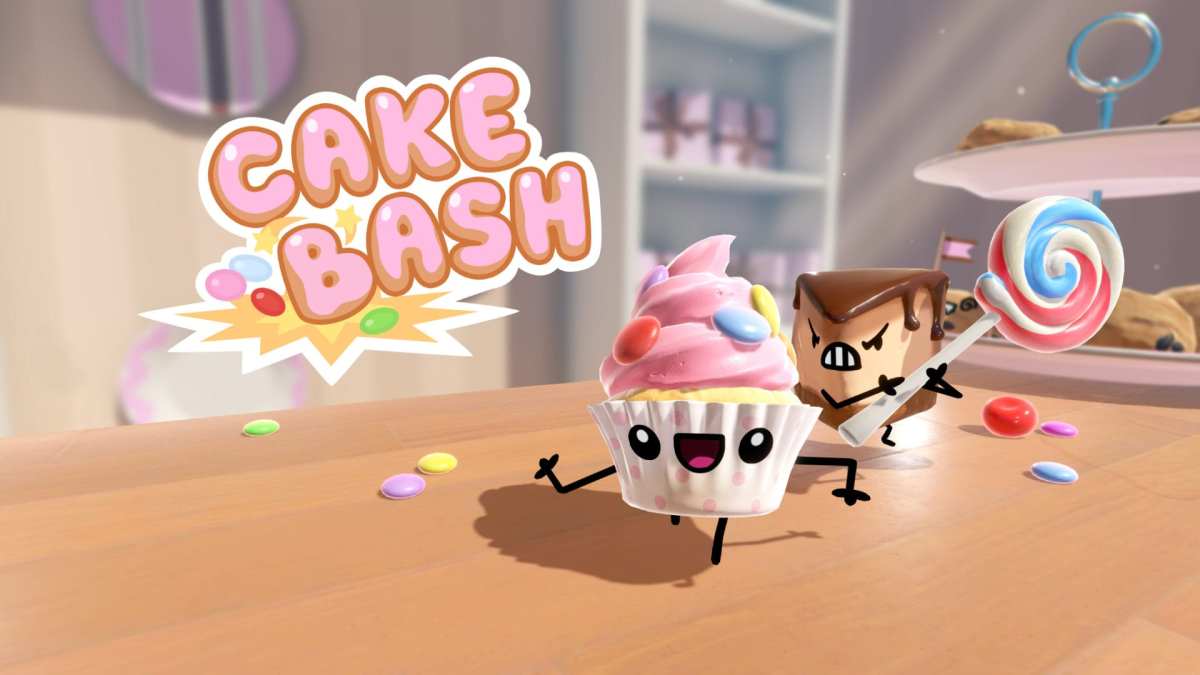There’s something special about a game that’s as attractive to parents as it is to their four-year-old child. That’s what Cake Bash is all about: accessible entertainment that puts a smile on the faces of the whole family.
But it’s more than just a wholesome distraction for casuals and young’uns; having played a few rounds myself, I can also confirm that running around as sugary treats smothering ourselves in delicious toppings also had a bunch of 30-year-old men giggling, too!
The premise is just so wonderfully silly, and it’s super fun to actually control. No wonder, then, that I’ve been keen to speak with the team at High Tea Frog about their unique little party game ever since.
Luckily for me, publisher Coatsink was able to organize a quick get together with High Tea Frog’s technical artist and director, Laura Hutton. All very well-timed, too, with this week’s announcement of a new brilliantly named battle royale mode called Fork Knife: Gateau Royale, as well as the announcement of a playable demo coming next week for Steam Summer Games Fest. Update 08/06/2020: The Steam Summer Games Fest has been postponed until June 16-22.
Here’s what Laura had to say about conceptualizing and designing Cake Bash, developing for different consoles, life as an indie studio after working at some of the industry’s big studios, and much more:
Senior Editor Alex Gibson: Cake Bash looks like an accessible sort of video game that anybody can hop into and have fun. Presumably, this was one of the core pillars of your design philosophy when developing the game? What else has been important in guiding Cake Bash’s design?
Laura Hutton: You’re right! We wanted to make it fun for everyone – at events we’ve seen parents tempted into a few matches with their children, even when they’re not usually interested in playing!
We’ve also been inspired by 90s party games. I still dig out Mario Party and Pokemon Stadium every time I visit my family. What makes them so special? Of course, nostalgia is a big factor, but I think there’s much more to it – even if you lose you have fun.
The scenarios and characters are enjoyable to look at, exciting to play, and there’s always the potential to get better with time and practice. We’re still finding new ways to play after all these years, and it’s something we wanted to explore in Cake Bash too.

We’ve woven skill and daft characters together in each of our games, and I hope players will want to learn how to get really good at them!
Alex: Did you find it challenging to strike a balance between building an accessible game and one that features enough depth to keep more experienced players interested?
Laura Hutton: We worked hard on making the combat feel good. One challenge we battled with was that something which was really satisfying for the attacker, (like landing a fully charged bash), felt unfair to the player on the receiving end. It was a constant balancing act but we ended up in a place we’re happy with after tweaking timings and values.
We have throwable weapons, a chargeable uppercut, a dash and a combo punch. All of these elements work well together and we’ve had some really intense matches! The game is much more complex than it looks at face value if you want to get really involved.
In saying that, some of our players at events have been as young as four, and they seem to enjoy just running around as a mad looking cake. The flailing arms, funny faces and sweeties are more than enough for them!
Alex: Talk to us about the stage/level designs in Cake Bash. There’s a lot going on in the background there, and it all looks fantastic. Each stage appears to have its own fun theme centered around some sort of kitchen appliance. How did you brainstorm these concepts, and were there some that were left on the table?
Laura Hutton: Heh, the table – one of our arenas is a patio table with a hungry pigeon! We actually built most of our levels around the central mechanics. We wanted them to be as different as possible to play, so we based them around unique concepts – boss fight (the Patio pigeon), disappearing floor (the Birthday cake). I built each of the level’s art assets around the core design.

They’re all based on real-life locations, to fit with the drawn-to-life theme. We had a couple of ideas that didn’t make it, like a pull out airplane table, a family barbeque and a sushi restaurant just for cakes! You never know, if people enjoy the game we would love to add more in the future.
Alex: Cake Bash’s various modes are presumably inspired by others that have featured in games gone by, but given the game’s premise is quite unique, what’s the focus testing process been like in regards to finding out what works and what doesn’t? Have you been working with specific focus groups, have you been experimenting at conventions like EGX, etc?
Laura Hutton: Our Publisher, Coatsink, has been taking the game to events like EGX and Bitsummit where we’ve had loads of valuable feedback. Player input has been so important in shaping our design – after only 4 months of development we took Cake Bash to a small local event, and quickly realized that some of our mechanics weren’t as fun as we thought and players were getting frustrated.
We made a list after watching them play, and after a focused week of hard work, the game was moving in a much better direction. We’re releasing our demo on June 9th on Steam, so I’m really looking forward to hearing what people think!
All in all, though, we just make what we think is fun. Some things look better on paper than they play- we’ve always been quick to iterate on designs and try as many new things as we can before settling on the best option. The amount of game ideas we prototyped and scrapped is huge, but we think that’s the best way to make games!
Because our team is tiny, so there’s no way we could make as much content as a bigger team could, so we’ve been very selective in deciding what we’ll ship with. We could have made quite a few more modes but the quality would have taken a dip. It’s definitely quality over quantity from us, but everyone seems to have a different favorite minigame or main game, so there’s something for everyone!
Alex: Speaking of game modes, Fork Knife has just been revealed, and it’s amusingly inspired by Fortnite’s battle royale mode. It seems as though the last-man-standing loop is fast-becoming a must-have for all multiplayer games; how did you adapt it to make sense for Cake Bash? For example, how did you approach design decisions such as the scale of the level, the complexity of the mechanics (if you’ve added any specifically for the mode), etc?
Laura Hutton: Fork Knife was too perfect an opportunity for a cake pun, so we built a whole minigame around the name. The tagline is ‘Gateau Royale’. We’ve tried to distill the last-man-standing theme from bigger games into a bite-sized laugh.
It’s a very fast-paced minigame, set on one pre-sliced cake, (whose name is Colonel Bash), and the slices are removed over time, reducing the playable area and making the cutlery more and more difficult to avoid. All of our minigames are designed from scratch and no mechanics are reused between any of them, which has been hard work but makes them all completely brand new, exciting to play and rewarding to unlock!
Alex: Cake Bash is coming to multiple platforms when it launches later this year. Have you experienced any challenges developing for any specific platform over another?
Laura Hutton: Each platform has its ups and downs, we’ve been optimizing from the start and testing early on consoles – Nintendo Switch is the most limiting so we tested early to see what we needed to scale back, and we’ve been careful not to leave anything to the last minute.
Each platform has its own new obstacles, sometimes a shader won’t display correctly, meaning a scone is missing a monocle, a s’more, a bow tie, but you never know until you test! The range of problems is so wide that it’s hard to remember, but you have to be good at spot the difference. I’m happy to say it’s working wonderfully on all consoles, loading quickly and playing well, and I’m really proud of what we’ve achieved.
Alex: Following on from that question, Nintendo Switch has fast become the go-to platform for smaller development teams, especially for studios whose specialty is the party game genre. Do you count yourself amongst those who consider the Switch as vital to the success of games like Cake Bash? Why do you think that is?
Laura Hutton: It’s hard to tell how important any one platform is until launch, but from what I’ve seen of the stats the Switch is a great place to be! There are a lot of games available on the eShop now though, so I just hope we can stand out enough to be noticed.

The Switch is a great console for a wide range of ages and interests, so we’ll have a good reach. Sales are important so we can make games in the future, but my measure of success is hearing about how much fun people are having!
Alex: I see that members of the High Tea Frog team have previously worked at AAA game studios such as Ubisoft. What are some of the key lessons you have all learned from working within that sort of environment that you believe have helped positively impact your ability to create innovative indie projects such as Cake Bash?
Laura Hutton: We wanted to keep the AAA quality but in a smaller package – we use tools and tricks inspired by big studios so it’s quick for us to iterate with design.
Our programmer, Clement is really focused on making things everyone can use, and optimizing repetitive tasks into something automated. The amount of time he’s saved me is probably in the thousands of hours by now.
I learned from big studios that you need to be interested and care about what the rest of the team is doing. If you don’t know how to do something, learn it well, or find someone who does! It’s really useful to have a bit of knowledge about all specialisms, and we’re both just as involved as each other in the design.
We’re doing our best to bring a really fun, polished experience to players. It’s taken a long time to get Cake Bash up to this level, but we wouldn’t release anything half baked. That’s in part thanks to working for a big company I think, but we’ve become used to a high standard.
Alex: Knowing what you do now –and assuming that you prefer making games under your own steam– would you recommend that aspiring game developers try to land positions at AAA game studios or do you now believe that it would have been better to steer your own course from the start?
Laura Hutton: Personally, I think it’s better to be part of an experienced team before starting out on your own.
If I compare what I knew at the end of university to what I knew even after a few years at Ubisoft, I don’t think I would ever have finished a game if I jumped straight in! The knowledge I gained from my peers is priceless, you get to meet new people, find out new, faster and better ways of doing things, and there’s less pressure when you’re financially stable and not responsible for everything in the game!
It can be hard to get criticism on something you put your heart into, but it’s easier to hear when you have a smaller part to play. You can build up a thicker skin.
It’s been a great journey so far, but I wouldn’t undervalue how important our development history has been in making a game that was attractive enough to get a publishing deal. Not many first-time indie devs have that security, and it takes a lot longer than you think to make a game!
There are some success stories for indies who have never worked for big companies before, and it can work for some people, but for me personally, my experience was really helpful.
Cake Bash will arrive on Xbox One, Nintendo Switch, PlayStation 4, and PC via Steam later this year.
A demo will be available to download for free from June 9 at 1 PM ET on Steam.













Updated: Jun 8, 2020 02:33 pm